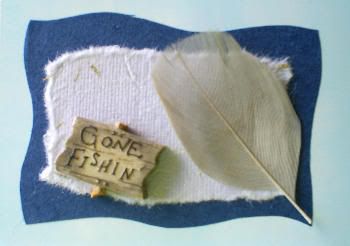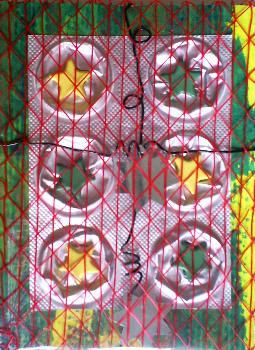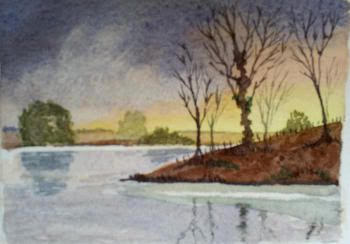Ok, having got my watercolours out, I decided to keep going. It is my first love (as far as art is concerned) so opened my sketch book and I idly found something to paint. The trouble with painting at home is finding inspiration, at least for me. This is a copy of a painting in a leisure magazine. Not too good but it was a first quick sketch. A few minutes only whereas Quiet Water was done at my art group and took me the best part of two hours.

- perhaps the open door should have been coloured in. The photo suffers from a low resolution scan image, always a problem with water colours. I took to photographing my paintings but didn't feel it was worth the effort here.
The next sketch was a freehand landscape out of my head ( I really like this sort of painting, and used to do them all the time. The more you do the more realistic and the more detailed they tend to become). This one needed a few birds to bring it to life.
I liked the colours in this one, I would rather be a little free with colours in a landscape than stick to too many greens. Not that there is anything wrong with green.... you understand. Again the sky shows the problem with low resolution scanning. It cannot cope with the subtlety of watercolours merging. I was fairly happy with this one, and I do like leafless trees/bushes. they don't hide the background.
The next picture was moving even further toward an abstract, something I have actually come to like since having to readup and learn about modern painting for a talk/workshop I gave to
my art group . (More later)
Don't ask me about this one, I had lots of blue left - I had used a very strong blue and mixed a large puddle, one of the problems of not having had the paints out for some time I guess. So I laid in a wash and made a few exploratory marks. And you know , I liked it. I think of it as reflections of poplar trees in a lake. You can make of it whatever you will.
But the talk I gave to my group....... A couple of years ago, we decided to try and inject a little something extra into our weekly meetings and to try to develop ourselves as artists (without being pretentious) we couldn't afford professional tutors/demonstrators so it was decided to hold quarterly workshops to be run by one of the group. I was chosen to do the first.... and because I was the only one who had done anything remotely abstract.... that was to be my subject.
I asked around the group what people expected and they said to me that they would like to go away from the workshop having painted an abstract painting. We are a very practical group, after all; and that seemed like a useful target.
I researched work by the masters from the impressionists to the american expressionists and decided that no matter what the painting, if it was any good (personal choice?) it had to follow the rules of composition. the biggest problem for most of the members was that of knowing where to start. So I devised a simple set of instructions, a bit like a recipe card. BUT the starting point was to be a small set of shapes/lines that they had chosen before putting pen/pencil/brush to paper. For example:- two squares, a circle and two lines. They were then to sketch in these shapes (thumbnail size - this was before I discovered aceo/atc) and colour them in.
Sounds simple - sounds childish? Don't believe it. For people who had only painted from pictures it was a major issue. Unfortunately none of them were inspired to do abstracts but I have cmpletely changed my own way of working and now do far more abstract work than figurative or realistic work.
Here are two examples from the list given above as an example, ie two square, two lines and a circle. It is interesting how such simple instructions can lead to such a variety of images. Why not try it for yourselves?


I actually love developing these little paintings and one can actually lose the shapes if the idea is taken one step further. But that will have to wait for another time, I have other things to do now. Thanks for your attention and your time, see you next time.





































